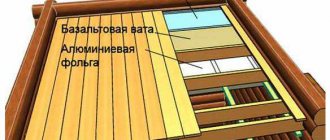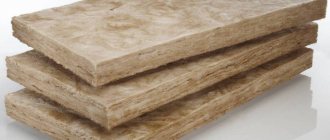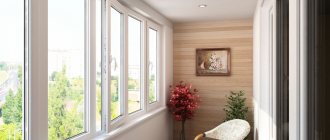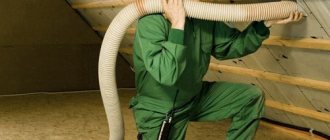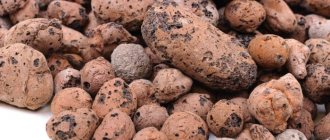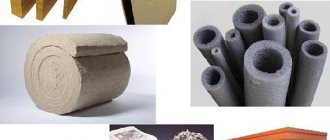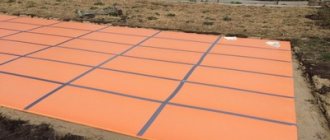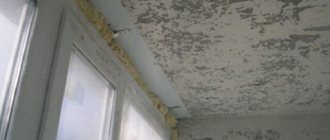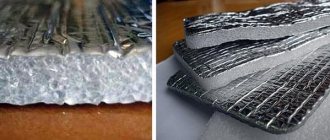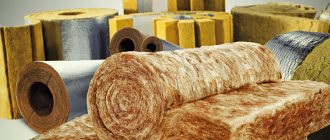First, briefly about what ceiling insulation provides
- Economical operation . Fast heating, due to reduced heat loss through the roof, allows you to reduce energy consumption (wood, coal, electricity, gas, etc.);
- Comfort for steamers . The absence of condensation that “pleasantly cools” people’s backs and the musty smell resulting from dampness;
- Durability of the structure . Prevents excess moisture, preventing the creation of a convenient bacteriological environment for the appearance of fungus, mold and wood rot.
Enough arguments? Then let's get down to business, and please pay attention to the next paragraph...
“When you have a bathhouse, just a bathhouse, you come, heat it, take a steam bath and leave, there is no need to insulate the roof. But if the attic or attic is used for storing clean linen, as a rest room, drying brooms and other household chores, then major insulation is necessary. Please note that we were talking about the roof. The ceiling must be insulated in any case. Many people confuse roof insulation with ceiling insulation.”
What types of ceilings are there in a bathhouse? Here are the main types - hemmed / floor / panel. Each option has its own design features. But the insulation process is almost the same. We will not consider this, since we have a different topic now.
So, materials. There are two main types of insulation for baths, which we roughly divide into natural (“old-fashioned”) and artificial (including those made on a natural basis with the addition of artificial substances).
Insulation of the ceiling in a bathhouse with a cold roof, depending on the characteristics of the roof
The roof of a bathhouse can be represented by one of two types: with an attic space and without it. In the first case, the air layer itself creates a fairly effective barrier, which has a positive effect on the building’s ability to retain heat. But this does not mean that the presence of an attic completely eliminates the need for insulation work.
If the bathhouse does not have an attic or attic, then high-quality thermal insulation is an almost mandatory condition for the further use of the building for its intended purpose.
Regardless of what type of room you are faced with, the first and extremely important step is to provide a vapor barrier layer. Available materials such as aluminum foil, high-density cardboard, which is pre-impregnated with drying oil, or wax paper are perfect for this.
Before laying the thermal insulation layer, you should take care of the reliable vapor barrier of the bathhouse roof
Helpful advice! If work is being done to insulate the ceiling in a bathhouse where there is an attic space, then it is recommended to coat the ceiling boards on the roof side with a layer of clay about 2-3 cm.
How to insulate
The ceiling of the bathhouse is usually insulated during the construction phase. Therefore, the choice of insulation is usually related to the type of ceiling:
- flat;
- hemmed;
- panel.
Mineral wool (=basalt wool for baths, because it is the most environmentally friendly) can be used in any type, but flooring is considered the most budget-friendly, so cheaper materials are often chosen for it. Insulating the bathhouse ceiling with mineral wool is a popular solution.
In any case, mineral wool needs to be insulated from water and steam, for which it is insulated on one side with a film or membrane, and on the other with foil (as the best vapor barrier).
You just need to remember that the vapor barrier is laid closer to the hot room (steam room, washing room), and the waterproofing is placed on top of the insulation from the attic side . For a better understanding, we present the sequence of layers of two “pies”.
The hemming consists of:
- ceiling beams;
- cranial bars;
- boards;
- vapor barriers;
- insulation;
- finished ceiling (eg lining).
Video
Look at the explanation of the above picture:
Flooring consists of:
- flooring boards;
- vapor barriers;
- insulation;
- optional waterproofing (not at all necessary, except in cases where dry sawdust is used, in which case a layer of clay or earth is needed on top for fire safety).
Video
Look at the explanation of the above picture:
Most often, in place of the insulation there is mineral wool or glass wool (the latter should not be used only above the steam room).
Expanded clay —
An excellent way to insulate a cheap floor ceiling for baths with a cold attic. You just need to make sure that the foundation and walls can withstand the weight of a 30-centimeter layer of this material.
The insulation technology is simple: when boards are laid on the wall framing (!about insulation for walls here) (and there are no floor beams in the project), wax paper is placed on top of them, and expanded clay of different fractions is scattered on top of it and leveled with a rake.
Then foil is stapled to the boards from below, slats for the ventilation gap are attached to it, after which the finishing ceiling is attached. Insulating the ceiling in a bathhouse with expanded clay is a time-tested solution.
Polystyrene foam is the most undesirable material for a bathhouse ceiling because it cannot withstand high temperatures, is flammable, and when burned also emits smoke with toxic substances. However, it begins to release harmful substances even when heated. However, many people ignore the danger and use it to insulate the ceiling because it does not weigh down the structure too much and is one of the inexpensive and accessible materials. Well, everyone is the architect of their own happiness. We advise you at least not to place it above the steam room or next to the stove. And check the certificates: sanitary and hygienic and fire.
Sheets of foam plastic are laid on the outside of the bathhouse ceiling on a pre-laid vapor barrier, for example, on foil insulation. Or instead of sheets, backfill with foam chips is used.
We repeat, we do not recommend insulating the bathhouse ceiling with polystyrene foam!
Insulating the ceiling of a steam room in a bathhouse
The steam room is a special room in the bathhouse, because it is here that any material is subjected to the greatest tests due to the combination of high temperature and humidity.
One of the consequences of these factors may be the release of volatile compounds, for example, phenols or formaldehydes contained in some types of insulation. Therefore, the insulation of the steam room must be approached with greater care than other rooms.
In addition, everything literally gets hot next to the chimney, and the stove is the main source of sauna fires, so fireproof materials will come in handy here.
On the other hand, the steam room must be insulated so that the hottest room cools down more slowly. For this purpose, it is usually turned into a “thermos” - covered with foil and insulation.
So, the “pie” scheme remains the same. When insulating the ceiling of a steam room from the inside, including with your own hands:
- The rough ceiling is covered with wax paper with a wide overlap at the joints.
- 5x5 cm bars are attached on top of the paper, between which insulation is then placed.
- Insulation is being installed.
- It is covered with a layer of vapor barrier - foil - with careful sealing of all joints and fastening holes with metal tape.
- Slats are placed on top of the foil, with the help of which the necessary ventilation gap is formed between the foil and the finishing of the ceiling.
- Decorative finishing - finished ceiling.
You should also familiarize yourself with the features of external insulation of bathhouse walls, in particular how to choose inter-crown insulation used for external thermal insulation.
Proper insulation of the ceiling of a Russian steam bath
The temperature in a Russian bath should not rise as high as in a Finnish one. After all, Russians go to the bathhouse for the steam, while Finns are satisfied with the dry heat. The optimal upper temperature limit is 90 degrees. It follows from this that in a Russian steam room the materials are attacked not so much by heat as by steam.
That is why it is better to refuse to decorate the ceiling of the steam room with clapboard - it is suitable for a Finnish bath, but in a Russian it is better to use a massive aspen or linden board. The thickness of the wood first gains and then gently releases heat.
A ventilation gap between the board and the vapor barrier is required; here it is also created by slats stuffed with foil.
Foil is also used in the Russian bath, no changes here. Here too it is better to lay it in two layers and overlap. In addition to foil, you can use foil kraft paper or Penotherm; for other materials, see their temperature limits. The foil is laid from the ceiling onto the walls - 10-20 cm, and at the junction it is glued with silicone sealant and closed with slats. But this is if the walls are without foil, and if with foil, then the ceiling is fastened to the wall with metal tape.
The foil is separated from the insulation by a rough ceiling, 25 mm thick. The insulation is taken in three layers of 50 mm each (mineral wool) and placed with the joints shifted so as not to create cold bridges. It doesn’t need any backing, it goes straight onto the boards.
If desired, a membrane is spread over the insulation in the attic so that the insulation can breathe and not get wet from above.
Next, you can build a finishing floor on top of the insulation if the attic will be used as an attic.
Nuances of insulating the ceiling in a two-tier bathhouse
Bathroom ceiling insulation scheme
In accordance with the design features of the structure, baths can be divided into 2 large groups: those with an attic/attic floor and those without one. The standard scheme for insulating the ceiling in a bathhouse without an upper tier was presented above. The procedure for thermal insulation of the ceiling in a bathhouse with more than 1 floor deserves separate consideration.
The technology for constructing a bathhouse with an attic floor involves installing a ceiling structure that is much more powerful in its performance. An additional obstacle to the flowing warm air masses will be the space under the roof itself, as well as, to some extent, the roof structure itself.
In bathhouses that do not have an attic/attic tier, warm air masses encounter much fewer obstacles, and their strength is also noticeably lower. Despite this, ceiling structures both in bathhouses with an upper tier and in buildings without one need high-quality and competent insulation.
Examples of proper ceiling insulation in a bathhouse with an attic/attic are shown in the following image.
Examples of proper ceiling insulation in a bathhouse with an attic/attic
Important note! If the ceiling is made of logs, a sheathing is installed on the side of the bathhouse, the logs are covered with a vapor barrier, a 20-centimeter layer of sand is poured on top and then insulation is carried out according to the standard scheme. Skull boards can be mounted on top of logs.
The design of the ceiling and roof of a bathhouse without an attic is as follows.
The design of the floor and roof of a bathhouse without an attic The structure of the floor and roof of a bathhouse without an attic
With a cold roof or with an attic - what's the difference?
If there is an attic floor, there is a problem with the penetrating temperature threshold from the steam room, from where a large amount of steam, warm and hot air rises and, accordingly, if it is not properly disposed of, it will accumulate in the attic space. Therefore, in order to insulate the ceiling in a bathhouse with a cold roof, you should carefully calculate the thickness of the ceiling insulation taking into account the loads and take care of better vapor and waterproofing.
There is an opinion that it is not necessary to insulate the ceiling in a bathhouse with an attic, but increasing the thermal insulation characteristics in it is more necessary than in an uninsulated attic space, where the heat penetrating outside does not encounter serious obstacles on its way.
Artificial insulation
Artificial - mineral wool of various types, ecowool, sprayed insulation. Their advantage : excellent thermal insulation, fire resistance, moisture resistance and durability. Disadvantages : complete or partial “unnaturalness” and price.
The list of artificial insulation materials does not include polystyrene foam, penoplex and some others. But they are not considered the best for a bath. Why? They belong to the so-called “non-breathable insulation”, and in the bathhouse, as you know, it is always humid. This moisture will have a bad effect on wooden structures. I also do not recommend using “poured” foam concrete, which carries loads and does not tolerate humidity and temperature changes.
Mineral wool “effectively, quickly and honestly returns every ruble invested.” It is divided into glass, stone and slag. They differ in the thickness and length of the fibers, load resistance, hygroscopicity, fire resistance and thermal conductivity. We will exclude glass wool for the reason stated above. Let's look at the rest in more detail.
Ceiling insulation with mineral wool
Slag wool: The starting raw material is blast furnace slag.
Advantages:
- — good thermal conductivity;
- — ability to withstand temperatures up to 300°C;
- - light weight;
- — excellent sound insulation qualities;
- - not friendly with mold and fungal spores
- — the price is 2-4 times lower than that of basalt insulation (stone wool);
“And mineral wool is the most convenient insulation when arranging attics with irregular geometry and uneven surfaces.”
Minor cons:
- - tendency to shrink;
- — high hygroscopicity (ability to absorb moisture);
- — brittle and prickly fibers of long length (gloves, a respirator and special clothing are required when laying).
Stone (basalt ) wool: The initial raw material is melted rocks based on basalt.
Advantages:
- — perfectly accumulates heat;
- — ability to withstand high temperatures (up to 1000°C);
- — the dense structure of the fibers ensures resistance to shrinkage (in comparison with “soft” slag);
- - low hygroscopicity (again in comparison with slag wool);
- - not to the taste of rodents;
- - not friendly with mold and fungal spores;
- — short and thick fibers, do not require a respirator when working;
- - longer service life (compared to slag).
Flaws:
- - high price;
- - more expensive transportation;
- - low elasticity, which does not allow effective insulation of uneven surfaces.
Ecowool insulation
Ecowool for insulating a bath ceiling would be an excellent option. It does not rot, retains heat well, and perfectly “regulates” temperature and humidity conditions, which is very important for working in “harsh” conditions. Rodents do not like it, it is absolutely fireproof and affordable.
Perhaps there is one drawback - not everyone knows how to work with it. And not many people know what it is. For those who are interested in this material, welcome here.
Sprayed insulation - it can be called a new product on the construction market. This is something similar to polyurethane foam, for example, Polinor. True, a significant number of such cylinders will be needed to insulate the ceiling, but for small areas, it will do just fine. For larger volumes, there are industrial installations for spraying polyurethane foam. Here is a video showing this method, and here is an article with a full description of the entire insulation technology...
Do-it-yourself insulation of a bathhouse ceiling: advantages and disadvantages of mineral wool
Mineral wool is by far the most popular option among all. It is often used for insulation not only of bathhouses and garages, but also for residential buildings. In itself, it is a fibrous material that has excellent thermal insulation characteristics and can be presented in one of three types:
- glass wool;
- stone wool;
- slag wool.
But if the first option is familiar to almost everyone, then not everyone has seen the other two. Rock wool is a material made primarily from basalt, although it is sometimes made from other rock melts. Slag wool is very similar to cinder blocks, for the production of which blast furnace slag is used.
Mineral wool is characterized by significant resistance to high temperatures and also has excellent heat and sound insulation properties
In addition to the fact that mineral wool has low thermal conductivity, which allows it to be used for thermal insulation of ceilings and walls, it has another significant advantage. Unlike other materials, it cannot serve as a breeding ground for microorganisms: fungi, mold, small insects or rodents, which is very useful for summer cottages.
As for other characteristics, mineral wool is not prone to fire and does not react in any way to temperature changes: it does not deform or shrink. Light weight and convenient packaging (usually in the form of rolls or rectangular slabs) make it easy and convenient to work with the material, even alone.
Of course, this material also has disadvantages that one way or another will have to be taken into account:
- mineral wool can absorb moisture;
- it contains phenols, which can potentially pose a hazard to human health.
Insulation with mineral wool is necessarily accompanied by additional waterproofing of the surface
Both of these disadvantages can be neutralized during the installation process, providing the insulation with high-quality vapor and waterproofing, completely eliminating the risk of contact of mineral wool with air under the ceiling. This is especially true for warm and humid air, which is concentrated indoors.
Helpful advice! Despite the fact that, if all installation rules are followed, mineral wool does not pose a real threat to health, during its installation it is necessary to be careful and use protective equipment, since its small fibers can cause irritation to the skin and eyes.
Insulation of the ceiling in a bathhouse with expanded clay: features of use
Expanded clay is small-sized pebbles that consist of clay and have a porous structure. If we take into account all the factors, then expanded clay can be called the most suitable material for insulating the ceiling in a bathhouse. Of course, if the building has attic space and there is a possibility of using it.
Distinctive features of expanded clay as an insulation material are the high hydrophobicity of the material, as well as resistance to the development of microorganisms and fungi
The advantages of this choice can confidently include the following aspects:
- expanded clay is completely safe: it does not support combustion, is environmentally friendly and even in the event of a fire will not release hazardous substances into the atmosphere;
- over time, as well as under the influence of external factors, expanded clay does not deteriorate and does not decompose;
- the cost of the material is quite low;
- bacteria and fungi do not consider expanded clay an attractive environment for life.
In addition, expanded clay is superior to mineral wool in its ability to not absorb moisture. And although the need to equip steam and waterproofing layers remains, the risk of moisture accumulation inside the insulation layer is much less. It should also be noted that the service life of expanded clay is one of the longest when compared with other materials.
Expanded clay can be used to insulate both ceilings and floors
Is it worth it to insulate the ceiling from the inside with polystyrene foam?
At a certain period, foam plastic was the leader among thermal insulation materials, which were used to insulate not only bathhouses, but also residential buildings. But with the advent of alternative options, its significant shortcomings became noticeable. So, for example, in the event of a fire, polystyrene foam burns well, while also emitting toxic smoke that can harm human health.
In addition, polystyrene foam is not very resistant to external factors, collapsing under the influence of high temperatures, which is inevitable if it is used in a bathhouse.
For these reasons, we can conclude that polystyrene foam is far from the most suitable material for this purpose and it is better to give preference to another material that is more stable and suitable for its characteristics.
Many builders prefer to insulate the ceiling of bathhouses with penoplex foam with a thermal layer rather than polystyrene foam
Using ecowool as insulation for a bath
Another material that is popular among insulation materials and is often used for bathhouses and garages is ecowool. This fibrous material is made from cellulose, adding special impurities to it to provide protection against insects, bacteria and rodents. In addition, they make ecowool resistant to fire.
The advantages of this material include environmental friendliness, as well as low weight and the ability to fill even the smallest cracks and gaps, which is very convenient when it comes to working with a not too smooth surface. It does not emit any toxic substances so, like expanded clay, it is completely safe for human health.
But there is also a significant drawback: the effectiveness of using ecowool is directly related to the presence of ventilation, as well as a high-quality waterproofing layer, which is designed to remove moisture. This is due to the fact that ecowool itself is very prone to absorbing condensation, which negatively affects its thermal insulation characteristics.
Ecowool, as an environmentally friendly material, is used for insulation and insulation of walls, floors and ceilings
There are two ways to apply this heat insulator to walls, the so-called “dry” and “wet”. The main difference and at the same time complexity of the second option is the need to use special equipment for this, the rental of which will cause quite high prices for insulating the ceiling using this method.
Insulating a bathhouse inside using a mixture of cement and sawdust
This method can confidently be called the oldest among all those described, since these materials were used for insulation long before thermal insulation materials such as polystyrene foam and mineral wool appeared on the market.
Interesting fact! Typically, cement and sawdust are used to create a suitable mixture. Although the option of replacing these components with clay and straw is quite acceptable.
First of all, prepare a dry mixture, which includes sawdust, lime and cement in a ratio of 10/1/1, respectively. After mixing all the dry ingredients, add 1.5 parts of water, pouring it in gradually and mixing thoroughly so that the solution is homogeneous. After this, all that remains is to place the mixture on the surface and level it to an even layer.
You can insulate a bathhouse from the inside using inexpensive materials such as cement and sawdust, mixing them in the correct proportions
Experts recommend using sawdust to create such a mixture, which has previously been dried for several months, or better yet, a whole year.
If all recommendations and technologies are followed, you can ultimately obtain high-quality, environmentally friendly material. Although we have to admit that in terms of thermal insulation characteristics it is still inferior to mineral wool and even expanded clay. So, perhaps, its only advantage is its low cost, which, however, entails quite a lot of hassle.
Selecting insulation
The melted bath maintains a very high temperature and humidity. The thermal insulation material must meet these conditions and, most importantly, not emit harmful substances when heated. In addition, a good insulation for a bath should be fire-resistant. It is undesirable for the thermal insulation material to be too heavy or inconvenient to carry and install. Now let's look at the materials in more detail.
Rules for the installation of multi-layer structures made of lumber
Mineral wool
It is the most common insulation option for baths and private houses; This is a fibrous thermal insulation material that exists in three types:
- glass wool;
- rock wool, which is made from basalt or other rock melts;
- slag wool, made, like cinder blocks, from blast furnace slag.
The main advantage of mineral wool, in addition to its very low thermal conductivity, is that it is not a breeding ground for fungi, mold, insects or rodents. For a bathhouse located on a private plot, this is especially important. It is also worth noting that this material does not burn, does not change its volume and shape when heated or cooled, and is very convenient to install due to its low weight. Mineral wool is produced in the form of rectangular panels or in the form of rolls.
Mineral wool
Mineral wool
Laying mineral wool
Laying mineral wool
As for the disadvantages, there are two of them - the ability of mineral wool to absorb moisture (especially for slag wool) and the potential harm of the phenols contained in them. Both of these disadvantages can be eliminated if you approach the issue of vapor and waterproofing wisely and prevent mineral wool from coming into contact with the air flow, especially inside the bathhouse.
Important! Small particles of mineral wool can have a damaging effect on a person’s eyes, skin or lungs, so when working with it, be sure to wear thick clothing and use gloves, safety glasses and a respirator.
Table. comparative characteristics of different types of mineral wool.
| Type | Fiber length, mm | Fiber thickness, microns | Thermal conductivity, W/(mK) | Flammability |
| Stone wool | 16 | From 4 to 12 | 0,042 | No |
| Glass wool | From 15 to 50 | From 5 to 15 | 0,4 | No |
| Slag | 16 | From 4 to 15 | 0,46 | High temperature sintering |
Expanded clay
They are small pebbles made of clay with a porous structure. Based on the totality of its advantages, expanded clay is the most suitable material for insulating the ceiling in a bathhouse.
- Safety - it does not burn, is environmentally friendly and does not emit harmful substances into the air.
- Durability - expanded clay does not decompose under the influence of sunlight and does not collapse over time.
- This material is not an attractive environment for fungus or bacteria .
- It has low cost and is easy to install.
Expanded clay also absorbs significantly less moisture than mineral wool, but the need for vapor barrier and waterproofing layers still remains.
Expanded clay
Styrofoam
At one time it was one of the leaders among thermal insulation materials. But even taking into account all its advantages, you should not choose polystyrene foam as ceiling insulation in a bathhouse - in the event of a fire, the material burns well, and its smoke is very dangerous to human life and health. It is also capable of decomposing simply under the influence of high temperatures (and they are inevitable in a bathhouse), so polystyrene foam can hardly be called a reasonable choice in this case.
Styrofoam
Ecowool
A natural fibrous material made from cellulose with additives that provide flame resistance and protection against rodents, insects and microorganisms. Ecowool is lightweight and has the ability to fill all cracks and gaps. Like expanded clay, it is environmentally friendly and does not emit any substances harmful to humans into the air.
However, ecowool can absorb a lot of moisture, which impairs its thermal insulation properties. Therefore, when using it, good ventilation under the roof and high-quality waterproofing are desirable. Another disadvantage of its use is the complexity of installation - the “wet” method of application requires special equipment.
“Wet” method of applying ecowool
A mixture of cement and sawdust
It is a “classic” material for insulation, which was used even before mineral wool or polystyrene foam appeared on the market. In some cases, clay can be used instead of cement, and straw instead of sawdust.
First, a dry mixture is prepared in the following proportion: for 10 parts of sawdust, take one part of cement and one of lime. The resulting dry mass should be filled with one and a half parts of water to obtain a fairly thick and homogeneous solution. The mixture is laid out on the surface and distributed in a fairly even layer.
Important! It is advisable to use sawdust that has been dried for several months or better than a year.
This material is very cheap and environmentally friendly, but it does not have such high thermal insulation as expanded clay or mineral wool. In addition, the process of its manufacture is labor-intensive, and after installation it is necessary to repair the resulting cracks (and they are inevitable).
Insulating the ceiling with a mixture of clay and sawdust
Other methods of thermal insulation of the ceiling in a steam room
The technology for performing thermal insulation using clay and mineral wool is as follows:
- For filing from below to the ceiling beams, an unedged board 5 cm thick is used.
- Outside, along the beams, a narrow board is attached using wood grouse. It is necessary to support the binder.
- Tongue-and-groove aspen boards are screwed to a fixed thin board; a ventilation gap must be left between them.
- Vapor barrier material is spread on the attic side.
- Then clay mixed with sawdust is laid in a 3 cm layer.
- Mineral wool is laid. You should take insulation with a density of 125 units and a width of 15 cm.
- To protect from the wind, a polypropylene film is laid.
- Finally, the attic floor is made from boards
If the bathhouse has a log floor, then the sheathing is first made, and then the sheathing is attached to it. Glassine is laid on top as a vapor barrier. Then sand is poured in a layer equal to 20 cm. The remaining actions depend on the wishes of the owner of the bathhouse.
To properly insulate a bathhouse, you need to know which insulation is best for a bathhouse on the ceiling, in what sequence the layers should be placed, as well as the features of insulating the ceiling in a steam room. The ceiling arrangement options described above can be changed depending on climatic conditions and personal preferences.
Features of the arrangement of vapor barrier and waterproofing layers
The presence of a vapor barrier layer is not a whim, but a real necessity. Especially when it comes to rooms such as a bathhouse, where hot air is an integral part of using the room for its intended purpose. Rising in the form of steam, moisture can have a destructive effect on the insulation and contribute to the formation of mold and mildew on the wooden elements of the bathhouse frame.
Scheme of insulation and insulation of a bathhouse roof
In order to avoid problems that may arise as a result of moisture accumulation on the ceiling and walls, special films and coating materials are used, for example, anti-condensation membranes. When choosing a suitable material, it is advisable to purchase one that has a foil layer.
Helpful advice! During the installation of a vapor barrier film, it is very important to pay attention to its integrity. It is necessary to prevent the occurrence of gaps, as this will greatly affect the technical characteristics of the coating.
To ensure waterproofing, special films are used, which can be purchased at hardware stores. Sometimes the most ordinary polyethylene of sufficient density or cheap roofing felt is used.
To protect the bath frame from moisture, it is recommended to use a waterproofing membrane, which can be mounted in contact with the insulation without losing its properties
Materials for vapor and waterproofing
For a bathhouse, vapor barrier of the ceiling is vital, otherwise rising moisture will not only worsen the thermal insulation properties of the insulation, but will also contribute to the development of fungi and mold on the ceiling itself and on the roof rafters . Specialized films and coatings are used as vapor barrier materials. Particular attention should be paid to anti-condensation membranes. When purchasing vapor barrier films, it is advisable to choose those with a foil layer.
Important! When working with such films, be careful and do not allow any rupture of the vapor barrier material or foil layer, otherwise its protective properties will significantly deteriorate.
As for waterproofing, you can use either special films, which can be found in any hardware store, or cheaper roofing felt or dense polyethylene.
Common vapor barrier materials: 1. Geosynthetics. 2. PVC membrane. 3. Glassine. 4. Tol. 5. Aluminum foil. 6. Thermofol.
Do-it-yourself insulation of a floor ceiling: step-by-step instructions
A deck ceiling is an excellent option for buildings that are used seasonally and have a small area. But in such a design there is not a lot of space for bulk insulation. In addition, such a ceiling is also not able to withstand a lot of weight. Therefore, the choice of material should be approached more responsibly.
In order to have enough space for laying insulation, the floor ceiling should be placed slightly lower than the height of the walls. And after that, you can begin step-by-step work according to the following instructions:
- First of all, it is necessary to lay a vapor barrier layer on the attic side. In this case, the side on which the foil is located should be facing down. The material is laid with an overlap of approximately 10-15 cm, and to ensure tightness, you also need to tape the joints with tape.
- The selected thermal insulation material is laid on top. In this case, mineral wool or expanded clay is best suited, since the floor ceiling is not intended for heavy loads.
- A layer of waterproofing material is placed on top, which can be roofing felt or polyethylene film. Laying must be done with an overlap, and the seams must be carefully taped.
- The final layer should consist of sheets of plywood or boards, which will provide reliable protection for the previous layers.
The flat ceiling is easy to use, particularly in terms of insulation. If necessary, layers of insulators can be replaced without much effort
This is a simple method that is relevant if you do not plan to spend too much money and time on it. If the area of the bathhouse is large enough or it is necessary to use the space under the roof for storage, then this option will not be very suitable due to its fragility. In this case, it is better to give preference to a false ceiling.
Insulation with expanded clay and sawdust
Some builders, when insulating the ceiling, choose a simpler solution and cover it with sawdust. This method has a right to exist, but one should remember the high fire hazard of sawdust. They need to be separated from the pipe. The pipe must be placed in a sleeve. The space between it and the chimney is filled with mineral wool.
A box is made around the sleeve in which fireproof material is placed. Expanded clay can act in this capacity. By the way, it has excellent thermal insulation parameters. You can simply fill the ceiling with it or fill the space between the joists (not forgetting about the vapor barrier).
You can prepare expanded clay concrete and fill the ceiling with a light screed made from it, but expanded clay has a significant drawback - its high price. It is cheaper to make a solution by replacing expanded clay with sawdust. For preparation you will need:
- 1 part cement;
- 10 parts sawdust;
- 1 part lime;
- 5-7 parts water.
Water is poured after mixing cement with lime and adding sawdust to them. If the screed will come into contact with wooden surfaces, then when preparing the solution in water, it is recommended to dilute copper sulfate (50 g of copper sulfate per 10 liters of liquid).
It is necessary to say a few words about sawdust used for attic insulation. They need long-term drying, which can last 10-12 months.
Do-it-yourself insulation of a false ceiling: step-by-step instructions
The design of a suspended ceiling involves attaching to the upper part of the wall not the flooring itself, but support beams, for which a wooden beam or several boards spliced together are most often used. A ceiling is attached to the beams above and below, which also serves as the floor of the attic. Well, in the middle between the top and bottom layers a layer of thermal insulation material is laid, as well as hydro- and vapor barriers.
The installation process may differ slightly depending on which insulation was chosen, however, in general, the technology remains the same. If mineral wool is used for this purpose, the procedure is as follows:
- The first layer of waterproofing material is laid, which is attached to the upper surface of the beams using a furniture stapler. As in all other cases, the overlaps must be at least 10 cm, and the joints must be additionally glued;
Scheme of arrangement and insulation of a false ceiling
- boards or plywood are laid on top of the waterproofing, thus ensuring strength and reliability of the structure;
- mineral wool of suitable thickness is placed in the spaces between the beams based on the following standards: 150-180 mm for regions with a temperate climate, 200-250 mm for regions characterized by severe frosts. As with waterproofing material, the connection of two separate parts of the material must be overlapped;
- The vapor barrier film is attached to the floor beams from the bottom side. It is highly recommended that its edges be attached to the top of the walls. Since this is a very delicate material, it is important to work with it carefully, avoiding damage and tearing;
- perpendicular to the beams, wooden slats are attached on top of the vapor barrier material;
- The final stage is attaching the lining using self-tapping screws or nails to these slats.
This insulated ceiling is very durable and can withstand heavy loads, so the attic space can be used to create an attic or as storage for various accessories.
The final layer of bathhouse ceiling insulation is the installation of a vapor barrier film, which must be handled quite carefully
Do-it-yourself insulation of the ceiling of a bathhouse without an attic: nuances of work
The technology for insulating a wooden or panel bath, in the case of a complete absence of an attic space, has some differences from those discussed earlier. In this case, it is necessary to secure the vapor barrier material, and then attach the insulation itself. The beam beam and the final layer - ceiling boards - are already attached to it.
Particular attention should be paid to the junction of the insulation and the pipe. First of all, this is necessary to ensure compliance with fire safety standards. The indentation provided for by the rules must be at least 200 mm. Naturally, you can’t just leave a hole, and therefore a simple box consisting of rafter legs is mounted. Its main role is the separation of insulation and pipes.
Helpful advice! The inside of the box can also be filled with thermal insulation material. True, it must be fire-resistant and not susceptible to high temperatures. For example, stone wool is suitable for this.
Before laying layers of insulation and insulation, it is recommended to treat the wooden ceiling with special means to eliminate the possibility of the development of harmful bacteria and fungi
Another important task that faces the owner who is insulating the ceiling of a bathhouse without an attic is to completely eliminate the risk of condensation. Therefore, all vapor and waterproofing materials must be of high quality and attached in strict accordance with the rules and regulations.
Main types of attic roofs
- Cold - for their installation, a sheathing is stuffed onto the rafters, taking into account the roofing covering, roofing material is attached to it, insulation is carried out along the ceiling, laying thermal insulation on it, which is covered with a vapor barrier on the room side, and a waterproofing membrane on the attic side;
- insulated - for exploited under-roof spaces - attics, additional elements are added to the previous components: insulation, vapor barrier, waterproofing, counter-lattice - timber with a section of 40 x 40, 50 x 50, 60 x 60 mm, placed on the rafters along their length. A waterproofing material is laid on the beam, protecting the insulation and roof from external moisture, then the sheathing is laid on which the roofing covering is attached. The spaces between the rafters are filled with appropriate insulation, and from the attic side it is covered with a vapor barrier layer.
Types of bathhouse ceiling insulation:
- outside - more convenient to use, most effective for a ceiling located under an uninsulated roof, the insulation is laid out on the attic floor and covered with a rough or finished floor;
- from the inside – it prolongs the durability of the material, there are no temperature changes, but you will have to “steal” a few centimeters of the height of the bathhouse, a frame is mounted on the ceiling, after fixing the first layer of vapor barrier, and insulation is placed in it, then the vapor barrier is again and the ceiling covering is attached.
How to insulate concrete floors
If you are completely confused by the wide range and do not understand what material to use, then take the advice of experienced builders. For example, with concrete floors it is recommended to use expanded clay.
No special preliminary preparation is required. For convenience, timber slats can be attached to the base of the roof. This will make it easier to check the uniformity of expanded clay distribution. Although this condition is advisory in nature.
So, pour expanded clay (30 cm thick) over the entire surface. An ordinary garden rake will help distribute the granules evenly. If the attic space will be used in the future and a floor is provided, then expanded clay is laid level.
If all the backfill is leveled, you need to lay the GIP. Durable polyethylene is quite suitable. It is distributed with an overlap of 10-15 cm. Scotch tape is glued to the joints.
If you want to make a floor, then planks are laid on the beams.
This is a fairly cheap and easy-to-follow method that will help you insulate the ceiling in a bathhouse with your own hands. But because it is cheap, it does not become less effective.
How to insulate the ceiling in a bathhouse from the outside
How to insulate the ceiling in a bathhouse from the outside - the main task of insulating the ceiling from the outside is to create a “thermos” effect. The heat that is pumped inside the bath should not escape outside.
To solve this issue, traditional modern materials are used: expanded clay, mineral wool and others in combination with waterproofing barriers.
Very often, professionals use the “layer cake” insulation method. To do this, the bathhouse ceiling is lined with blocks about 6 centimeters thick.
Then a layer of vapor barrier (aluminum foil or cardboard) is laid. And the final stage is insulation with expanded clay, sand, mineral wool or clay with sawdust.
Clay insulation
Clay has long been used to insulate the attic of a bathhouse. You can simply coat the ceiling with a solution from it in several layers: the bathhouse will become much warmer. Lime added to it improves the properties of insulation.
It gives the solution antiseptic properties and makes it more plastic. True, clay usually cracks when it dries, so it is applied to the ceiling in several layers, giving each one time to harden and covering it before applying the next crack. The solution is reinforced with sawdust or straw, which makes it lighter and improves thermal insulation characteristics.
A solution of clay with sawdust consists of:
- 5 parts clay;
- 10 parts sawdust;
- 1 part lime;
- 7-10 parts of water.
Before preparing the solution, the clay is poured with water until completely soaked. Sawdust is mixed with lime. Then all the components of the future insulation are connected. You can add a little copper sulfate to the solution, which will improve its antiseptic characteristics.
When preparing a solution from clay and straw, maintain their ratio of 1:1.5 (no lime is added to the mixture). First, the dry ingredients are mixed, then they are filled with water.
The solution should not be too steep in order to be well distributed over the area, but you should not use a composition that is too liquid, which loses its homogeneity. By the way, getting rid of excess water is quite simple: just leave the solution for a day, allowing it to evaporate.
If the attic above the bathhouse will be intensively used, then it is better to lay clay and sawdust between the joists, on which the flooring can later be laid. Logs can be placed on both wooden and concrete ceilings. In any case, they must be treated with compounds that prevent wood rotting.
It is better to put a vapor barrier membrane on top of the insulation, and its presence under the heat insulator is mandatory. It must be laid, ensuring that all joints are sealed. Insulating the attic of a bathhouse with clay is a lengthy process. It may take several weeks. The thickness of clay insulation ranges from 5 to 15 cm.
How to insulate a bathhouse ceiling inexpensively
The most economical, but labor-intensive option for insulating the ceiling in a bathhouse is the use of sawdust, clay and sand. Roofing felt or isolon is laid in the attic with an overlap of at least 10 centimeters.
Then a thick layer of sawdust of at least 20 centimeters is poured, and the top is insulated with earth or clay. It is better to take sawdust from carpentry, as the shavings are drier and lighter.
The downside is that thermal insulation solely depends on the density and thickness of the insulation layer.
The use of mineral wool is also considered one of the inexpensive ways to insulate the ceiling.
The presence of an attic is not necessary. The main thing is the presence of floor beams on which the material can be attached.
Thus, we can conclude that not all insulation methods are expensive and require special training. Subject to the availability of high-quality material, as well as compliance with technological recommendations, you can be sure that the necessary heat in the premises will be maintained.
Materials for ceiling insulation
The process of insulating the ceiling is quite simple. And if you approach its implementation correctly, it can be done without involving a team of craftsmen. That is, significantly saving your money.
Today, in any hardware store you can purchase everything you need to insulate a bathhouse.
The only question is, what exactly to choose?
Insulation of any ceiling takes place in three stages:
- installation of vapor barrier;
- laying insulation;
- installation of waterproofing.
A properly executed layer cake, covered with decorative material, will cope with all responsibilities perfectly.
Expert advice
We went through popular YouTube channels, where they talk about baths authoritatively, knowledgeably, by people whose opinions we ourselves listen to. But the only problem is that they talk about a lot of things, but for some reason the problem of insulating ceilings, as well as the choice of materials, does not attract everyone’s attention.
Therefore, don’t blame me, the example of expert advice on ceiling insulation will be the video below, made - we simply couldn’t find anything more significant.
But what’s interesting is that you won’t hear standard descriptions in it. On the contrary, the authors of the video turn to the experience of previous generations and offer the most budget-friendly, simplest option for organizing both the ceiling itself and its insulation - this is a completely simple floor ceiling, insulated... with sawdust and clay. It couldn't be simpler.
You don’t even need to bother with the lining - you can make the flooring boards into a finished ceiling if you plan and sand them first.
Of course, any opinion will be controversial, and you have the right to question it or not consider it an expert.
***
Now that it is already clear why a ceiling without insulation is a waste of heat, all that remains is to wish every owner that in any weather his bathhouse will warm up properly and keep warm for the second day.
Video - We insulate the ceiling in a bathhouse with a cold roof using mineral wool
The process of insulating the shed ceiling of a bathhouse with a cold roof looks a little different when expanded clay or a cement-sawdust mixture is used. Let's present this in the form of step-by-step instructions.
Ceiling insulation scheme with expanded clay
- A rough flooring made of boards is laid on the floor beams below. The gaps between them must be treated with sealant or coated with a mixture of clay (or concrete) and sawdust.
- A vapor barrier film is laid on the flooring both from the steam room side and from the roof side, and not only the boardwalk should be covered, but also the beams themselves.
- Expanded clay is poured into the resulting boxes or ecowool is laid.
- Roofing felt or other waterproofing material is laid over the insulation overlapping and secured to the beams using a construction stapler.
- Boards or plywood are laid over the waterproofing to form the attic floor.
- The lining is laid underneath on the rough boards.
Insulation of a false ceiling with expanded clay
If you use a mixture of clay and sawdust to insulate the ceiling, then it is advisable to put a layer of mineral wool on top of the frozen mixture or fill it with expanded clay - this will improve the thermal insulation performance.
Important! The optimal layer thickness of a mixture of clay and sawdust for using a bathhouse in the warm season is 50 mm. If you plan to steam in it in winter, then you will need to make a layer of insulation of at least 150 mm.
Insulation of the ceiling in the bathhouse
The bathhouse has 3 main rooms - a steam room, a washing room and a relaxation room . Their floor insulation scheme is approximately the same, but the steam room floor has its own nuances.
Insulation technology:
- Floor beams are used as a basis. From below, these beams are hemmed with a rough plank ceiling. In the flooring version, the role of the rough ceiling is played by the flooring.
- Under the rough flooring, the ceiling, and along with it the walls, are sheathed with foil; it simultaneously serves as a heat reflector and waterproofing.
- A counter-rail with a thickness of 25–50 mm is placed on the foil along the beams.
- According to the rules, a finishing finish is nailed onto the counter-batten, but experienced craftsmen recommend first sewing plank flooring with a thickness of 40 mm or more, and then nailing the lining, so the ceiling becomes a heat accumulator.
- Next, a vapor barrier is installed on the ceiling of the bathhouse on the attic side. The vapor-permeable side is directed downwards, and the rolls of fabric are overlapped and sealed with foil tape.
- Vapor-permeable insulation is laid over the vapor barrier.
- The insulation is covered with the same layer of vapor barrier on top, after which the attic floor is installed.
The use of foil as a reflector in the steam room is mandatory.
The insulation scheme for the remaining rooms differs only in that it is not necessary to install a layer of foil under the finishing cladding, otherwise the cake is absolutely the same.
How to line a pipe in a bathhouse in the attic - when the stove is running, the temperature of the pipe can reach up to 400ºC.
There are 2 materials suitable for thermal insulation:
- stone wool;
- expanded clay
Cotton wool is of course better, since you need to make a metal box under the bulk expanded clay.
The bath pipe is insulated with basalt wool or expanded clay; the first option is more convenient and easier to install
